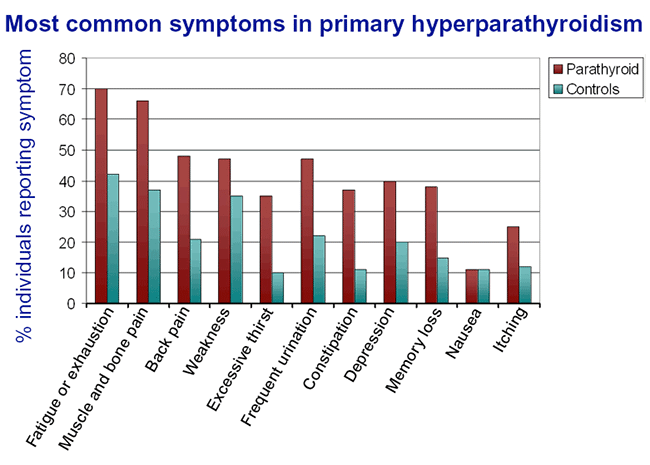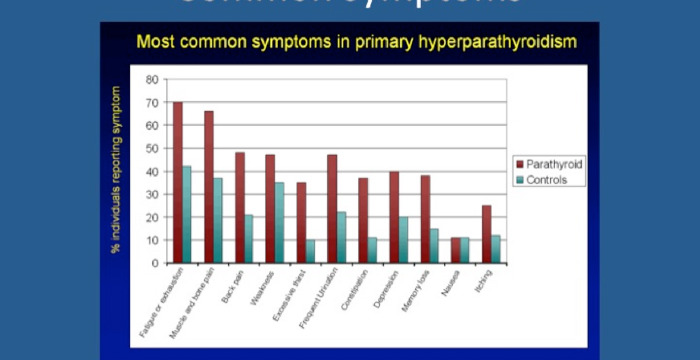This chart shows the wide variety of symptoms that patients with hyperparathyroidism may have. The red bars show patients and the green are comparisons with healthy patients. This is a common way of reporting result in scientific journals.

Boston Thyroid, Parathyroid and General Surgeon

This chart shows the wide variety of symptoms that patients with hyperparathyroidism may have. The red bars show patients and the green are comparisons with healthy patients. This is a common way of reporting result in scientific journals.

An elevated blood calcium is detected frequently because of routine blood testing. However even when the blood calcium is elevated many patients are not investigated to exclude hyperparathyroidism and the diagnosis may be delayed for years.
A recent report from the Cleveland Clinic showed that only about 1% of patients with hyperparathyroidism were properly diagnosed and only 0.3% of those diagnosed were treated by surgery, despite many of these patients having the criteria for surgical treatment.
There are guidelines for recommending surgery in hyperparathyroidism and they include any patient with symptoms ( see later slide), and patients without apparent symptoms if:
General Information Link:
http://endocrinediseases.org/parathyroid/parathyroid_background.shtml
| Cookie | Duration | Description |
|---|---|---|
| cookielawinfo-checkbox-analytics | 11 months | This cookie is set by GDPR Cookie Consent plugin. The cookie is used to store the user consent for the cookies in the category "Analytics". |
| cookielawinfo-checkbox-functional | 11 months | The cookie is set by GDPR cookie consent to record the user consent for the cookies in the category "Functional". |
| cookielawinfo-checkbox-necessary | 11 months | This cookie is set by GDPR Cookie Consent plugin. The cookies is used to store the user consent for the cookies in the category "Necessary". |
| cookielawinfo-checkbox-others | 11 months | This cookie is set by GDPR Cookie Consent plugin. The cookie is used to store the user consent for the cookies in the category "Other. |
| cookielawinfo-checkbox-performance | 11 months | This cookie is set by GDPR Cookie Consent plugin. The cookie is used to store the user consent for the cookies in the category "Performance". |
| viewed_cookie_policy | 11 months | The cookie is set by the GDPR Cookie Consent plugin and is used to store whether or not user has consented to the use of cookies. It does not store any personal data. |